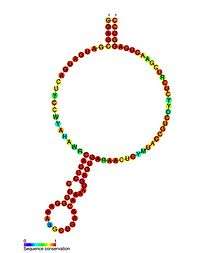Small nucleolar RNA SNORD116
SNORD116 (also known as HBII-85) is a non-coding RNA (ncRNA) molecule which functions in the modification of other small nuclear RNAs (snRNAs). This type of modifying RNA is usually located in the nucleolus of the eukaryotic cell which is a major site of snRNA biogenesis. It is known as a small nucleolar RNA (snoRNA) and also often referred to as a guide RNA.
| Small nucleolar RNA SNORD116 | |
|---|---|
 Predicted secondary structure and sequence conservation of SNORD116 | |
| Identifiers | |
| Symbol | SNORD116 |
| Alt. Symbols | snoHBII-85; HBII-85 |
| Rfam | RF00108 |
| Other data | |
| RNA type | Gene; snRNA; snoRNA; CD-box |
| Domain(s) | Eukaryota |
| GO | 0006396 0005730 |
| SO | 0000593 |
| PDB structures | PDBe |
SNORD116 belongs to the C/D box class of snoRNAs which contain the conserved sequence motifs known as the C box (UGAUGA) and the D box (CUGA). Most of the members of the box C/D family function in directing site-specific 2'-O-methylation of substrate RNAs.[1]
In the human genome, there are 29 tandemnly repeated copies of SNORD116, followed by 48 copies of another C/D box snoRNA, SNORD115, in the Prader–Willi syndrome (PWS) region of chromosome 15.[2] Unlike most other snoRNAs, SNORD116 is expressed prevalently in the brain (but is absent in PWS patients) and lacks any significant complementarity with ribosomal RNA. Mouse models of PWS show similar symptoms to humans (hyperphagia and growth deficiency), providing further evidence that PWS is directly linked to the deletion of SNORD116.[3][4]
More evidence comes from the discovery of two individuals that share many traits of PWS sufferers, both have atypical microdeletions on chromosome 15q11–13, the intersection of which contains only the SNORD116 snoRNAs.[5][6] An early paper had suggested SNORD116 did not have a primary role in PWS.[7]
The targets of SNORD116 are unknown, however a bioinformatic screen located 23 possible targets within protein-coding genes, of these a large fraction were found to be alternatively spliced, suggesting a role of SNORD116 in the regulation of alternative splicing.[8]
References
- Galardi, S.; Fatica, A.; Bachi, A.; Scaloni, A.; Presutti, C.; Bozzoni, I. (October 2002). "Purified Box C/D snoRNPs Are Able to Reproduce Site-Specific 2'-O-Methylation of Target RNA in Vitro". Molecular and Cellular Biology. 22 (19): 6663–6668. doi:10.1128/MCB.22.19.6663-6668.2002. PMC 134041. PMID 12215523.
- Cavaillé J, Buiting K, Kiefmann M, et al. (2000). "Identification of brain-specific and imprinted small nucleolar RNA genes exhibiting an unusual genomic organization". Proc. Natl. Acad. Sci. U.S.A. 97 (26): 14311–6. Bibcode:2000PNAS...9714311C. doi:10.1073/pnas.250426397. PMC 18915. PMID 11106375.
- Skryabin BV, Gubar LV, Seeger B, et al. (2007). "Deletion of the MBII-85 snoRNA Gene Cluster in Mice Results in Postnatal Growth Retardation". PLoS Genet. 3 (12): e235. doi:10.1371/journal.pgen.0030235. PMC 2323313. PMID 18166085.
- Ding F, Li HH, Zhang S, et al. (2008). Akbarian S (ed.). "SnoRNA Snord116 (Pwcr1/MBII-85) Deletion Causes Growth Deficiency and Hyperphagia in Mice". PLoS ONE. 3 (3): e1709. Bibcode:2008PLoSO...3.1709D. doi:10.1371/journal.pone.0001709. PMC 2248623. PMID 18320030.
- Sahoo T, del Gaudio D, German JR, Shinawi M, Peters SU, Person RE, Garnica A, Cheung SW, Beaudet AL (2008). "Prader-Willi phenotype caused by paternal deficiency for the HBII-85 C/D box small nucleolar RNA cluster". Nat Genet. 40 (6): 719–21. doi:10.1038/ng.158. PMC 2705197. PMID 18500341.
- de Smith AJ, Purmann C, Walters RG, et al. (June 2009). "A deletion of the HBII-85 class of small nucleolar RNAs (snoRNAs) is associated with hyperphagia, obesity and hypogonadism". Hum. Mol. Genet. 18 (17): 3257–65. doi:10.1093/hmg/ddp263. PMC 2722987. PMID 19498035.
- Runte M, Varon R, Horn D, Horsthemke B, Buiting K (2005). "Exclusion of the C/D box snoRNA gene cluster HBII-52 from a major role in Prader-Willi syndrome". Hum Genet. 116 (3): 228–30. doi:10.1007/s00439-004-1219-2. PMID 15565282.
- Bazeley PS, Shepelev V, Talebizadeh Z, Butler MG, Fedorova L, Filatov V, Fedorov A (2008). "snoTARGET shows that human orphan snoRNA targets locate close to alternative splice junctions". Gene. 408 (1–2): 172–9. doi:10.1016/j.gene.2007.10.037. PMC 6800007. PMID 18160232.